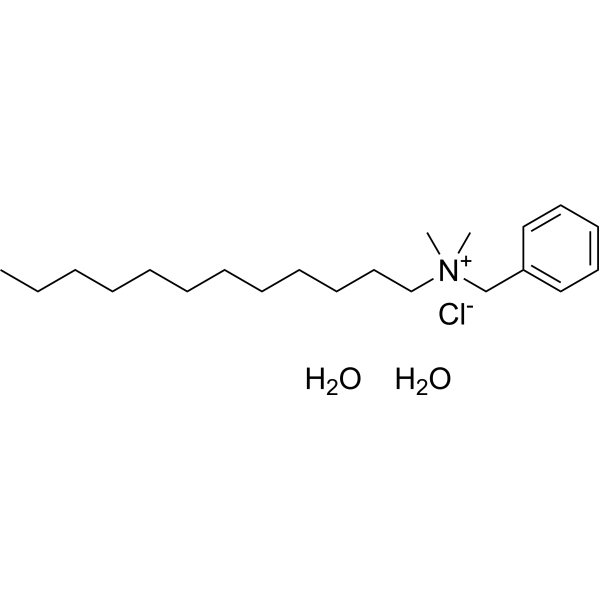
Benzyldodecyldimethylammonium Chloride Dihydrate
CAS No. 147228-80-6
Benzyldodecyldimethylammonium Chloride Dihydrate( —— )
Catalog No. M27530 CAS No. 147228-80-6
Benzyldodecyldimethylammonium chloride dihydrate is a quaternary ammonium compound (QAC).
Purity : >98% (HPLC)
 COA
COA
 Datasheet
Datasheet
 HNMR
HNMR
 HPLC
HPLC
 MSDS
MSDS
 Handing Instructions
Handing Instructions
| Size | Price / USD | Stock | Quantity |
| 500MG | 50 | In Stock |


|
| 1G | Get Quote | In Stock |


|
Biological Information
-
Product NameBenzyldodecyldimethylammonium Chloride Dihydrate
-
NoteResearch use only, not for human use.
-
Brief DescriptionBenzyldodecyldimethylammonium chloride dihydrate is a quaternary ammonium compound (QAC).
-
DescriptionBenzyldodecyldimethylammonium chloride dihydrate is a quaternary ammonium compound (QAC). Benzyldodecyldimethylammonium chloride dihydrate can be used as a biocide to target antibiotic-resistant bacteria, such as methicillin-resistant Staphylococcus aureus (MRSA), multidrug-resistant (MDR) P. aeruginosa et. al. Benzyldodecyldimethylammonium chloride dihydrate, an antimicrobial agent, bacteriostatic or bactericidal properties depending on the concentration.(In Vitro):Benzyldodecyldimethylammonium chloride dihydrate interacts strongly with cell surfaces in a concentration-dependent manner, and binds by ionic and hydrophobic interactions to microbial membrane surfaces, as manifested by phenomena such as membrane disruption and loss of membrane integrity with consequent leakage of essential intracellular constituents, which promote significant and irreversible changes in the cell structure. Benzyldodecyldimethylammonium chloride dihydrate (0-40 mg/L; 0-24 hours) inhibits P. fluorescens with a MIC of 20 mg/L. At 5 mg/L, cells have the same growth behaviour as the control. At concentrations of 10 and 15 mg/L the growth profile is different from the control, and the cells start to grow only after 8 h of adaptation. At concentrations of ≥20 mg/L, BDMDAC inhibits cell growth.(In Vivo):Benzyldodecyldimethylammonium chloride dihydrate (1-10 μM; 2 hours) results in a dose-dependent changes in the percent population of dead rat thymocyte cells.
-
In VitroBenzyldodecyldimethylammonium chloride dihydrate (1-10 μM; 2 hours) results in a dose-dependent changes in the percent population of dead rat thymocyte cells.Benzyldodecyldimethylammonium chloride dihydrate (0-40 mg/L; 0-24 hours) inhibits P. fluorescens with a MIC of 20 mg/L. At 5 mg/L, cells have the same growth behaviour as the control. At concentrations of 10 and 15 mg/L the growth profile is different from the control, and the cells start to grow only after 8 h of adaptation. At concentrations of ≥20 mg/L, BDMDAC inhibits cell growth.Benzyldodecyldimethylammonium chloride dihydrate interacts strongly with cell surfaces in a concentration-dependent manner, and binds by ionic and hydrophobic interactions to microbial membrane surfaces, as manifested by phenomena such as membrane disruption and loss of membrane integrity with consequent leakage of essential intracellular constituents, which promote significant and irreversible changes in the cell structure. Cell Viability Assay Cell Line:Rat thymocyte cells Concentration:0, 5, 10, 15, 20 and 40 mg/L Incubation Time:2 hours Result:Resulted in cell death.Cell Proliferation Assay Cell Line:Bacterial P. fluorescen Concentration:0, 5, 10, 15, 20 and 40 mg/L Incubation Time:2 hours Result:Inhibited bacterial growth in a time and dose dependent manner.
-
In Vivo——
-
Synonyms——
-
PathwayGPCR/G Protein
-
TargetAntibacterial
-
RecptorSKP2 E3 ligase|Apoptosis
-
Research Area——
-
Indication——
Chemical Information
-
CAS Number147228-80-6
-
Formula Weight376.02
-
Molecular FormulaC21H42ClNO2
-
Purity>98% (HPLC)
-
SolubilityIn Vitro:?DMSO : 100 mg/mL (265.94 mM)
-
SMILESO.O.[Cl-].CCCCCCCCCCCC[N+](C)(C)Cc1ccccc1
-
Chemical Name——
Shipping & Storage Information
-
Storage(-20℃)
-
ShippingWith Ice Pack
-
Stability≥ 2 years
Reference
1.Rico-Bautista E, Zhu W, Kitada S, Small Molecule-Induced Mitochondrial Disruption Directs Prostate Cancer Inhibition via UPR Signaling. Oncotarget. 2013 Jul 14.
molnova catalog



related products
-
Eravacycline dihydro...
Eravacycline dihydrochloride (TP-434-046)?is a potent and broad-spectrum antibacterial agent against six E. coli (MICs: 0.125-0.25 mg/L).
-
3-Hydroxy-C4-HSL
3-Hydroxy-C4-HSL (N-3-hydroxybutyryl-L-Homoserine lactone) is an N-acyl homoserine lactone obtained from pathogenic Vibrio vulnificus in fish and is a bacterial group sensing (QS) inducer that modulates bacterial signaling and can be used in the study of bacterial infections.
-
LL-3858 dihydrchlori...
A novel anti-TB agent that has an MIC range of 0.06-0.5 ug/mL.



 Cart
Cart
 sales@molnova.com
sales@molnova.com


